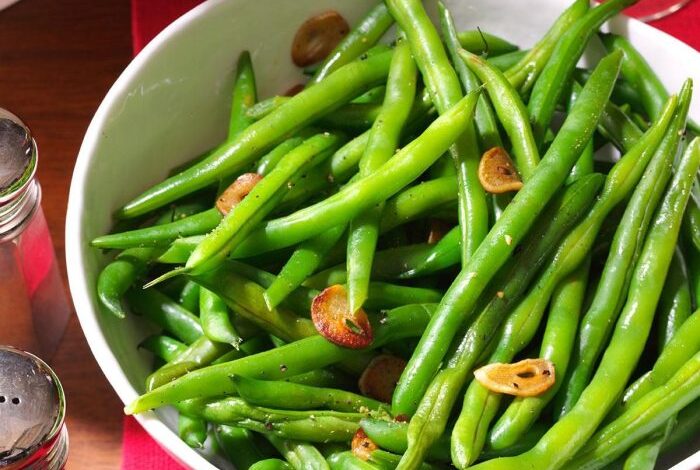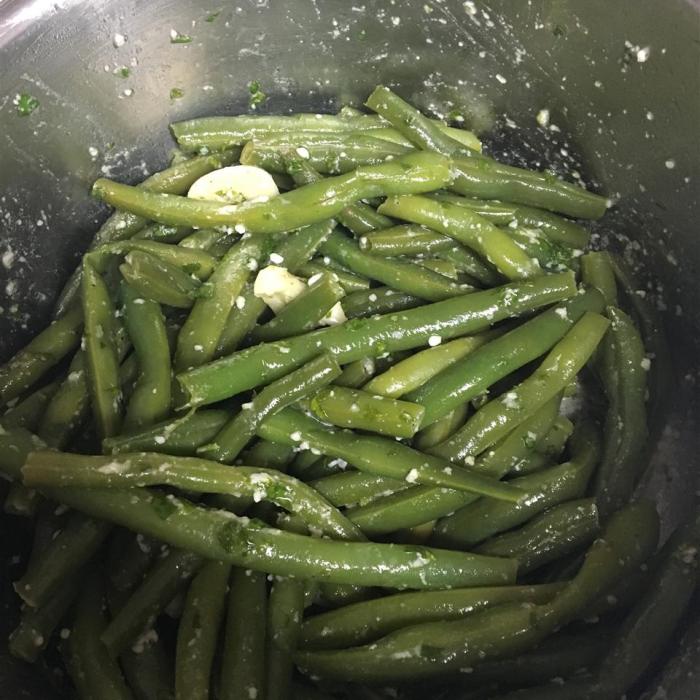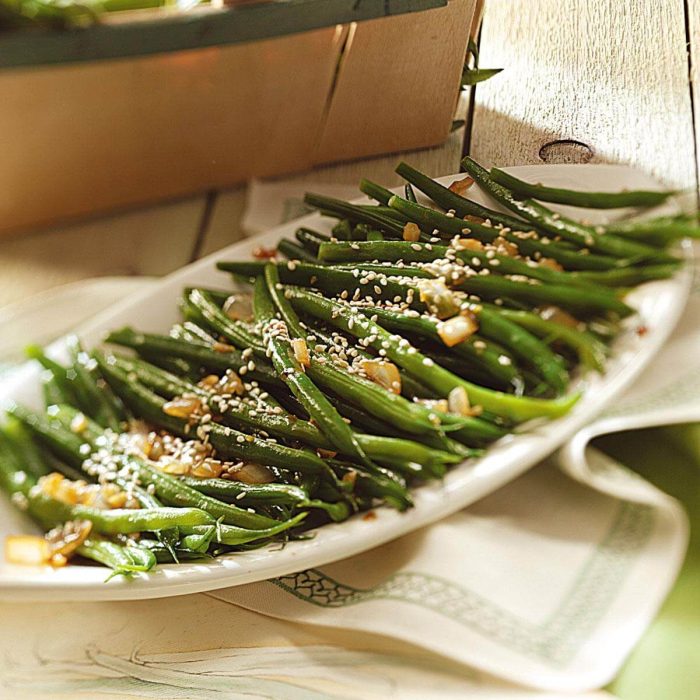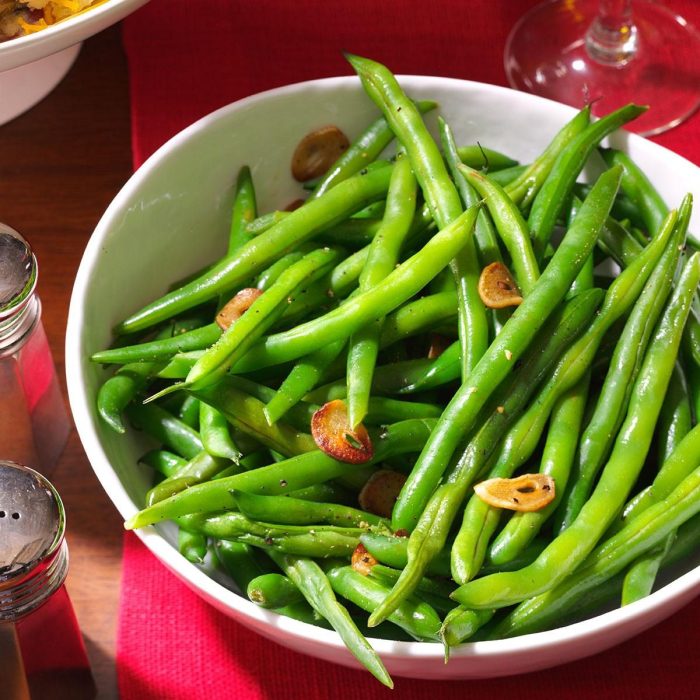
Easy Garden Green Beans: A Beginners Guide to Success
Easy garden green beans sets the stage for this enthralling narrative, offering readers a glimpse into a story that is rich in detail and brimming with originality from the outset. Growing your own green beans can be a rewarding experience, providing fresh, delicious vegetables right from your backyard.
While some varieties can be tricky, there are plenty of easy-to-grow options that are perfect for beginner gardeners. With the right preparation and care, you can enjoy a bountiful harvest of crisp, flavorful green beans throughout the growing season.
This guide will walk you through everything you need to know to successfully grow easy garden green beans, from choosing the right variety to harvesting and enjoying your bounty. We’ll cover topics like preparing your garden, planting, caring for your plants, and troubleshooting common problems.
Whether you have a small patio or a large garden, this guide will help you create a thriving green bean patch that will provide you with fresh, homegrown vegetables all summer long.
Growing Green Beans: Easy and Delicious

Green beans are a popular vegetable that can be enjoyed fresh, frozen, or canned. They are a versatile ingredient that can be added to salads, stir-fries, soups, and stews. Growing your own green beans is a rewarding experience, as you can enjoy the fresh flavor and satisfaction of harvesting your own produce.Choosing an easy variety of green beans is crucial for success, especially for beginner gardeners.
These varieties are known for their resilience, fast growth, and adaptability to various growing conditions. Proper preparation is essential for a successful green bean harvest. It ensures your plants thrive and yield abundant, delicious beans.
Preparing for Success
Before planting, it’s important to prepare the soil to ensure optimal growth conditions. Green beans prefer well-drained, fertile soil with a pH between 6.0 and 7.0. Here are some steps to prepare your garden bed for planting:
- Clear the area of any weeds or debris.
- Test the soil pH and amend it if necessary with lime or sulfur.
- Incorporate compost or other organic matter to improve soil fertility and drainage.
- Till the soil to a depth of 6-8 inches.
You can also use a raised bed for growing green beans, which offers better drainage and soil control.
Choosing the Right Green Bean Variety

With so many green bean varieties available, choosing the right one for your garden can feel overwhelming. But, with a little research and consideration of your climate and growing conditions, you can select a variety that will thrive in your garden and provide you with a bountiful harvest of delicious green beans.
Easy garden green beans are a staple in my summer garden. I love the fresh, crisp taste and the versatility of this vegetable. It’s perfect for steaming, stir-frying, or even adding to salads. But let’s be honest, sometimes you crave something sweet and delicious.
That’s when I turn to the best rolled sugar cookies for a satisfying treat. They’re soft, chewy, and perfectly sweet, making them the perfect complement to a fresh, healthy green bean dish.
Easy-to-Grow Green Bean Varieties
There are several easy-to-grow green bean varieties that are perfect for beginner gardeners. These varieties are known for their resilience, adaptability, and delicious flavor.
- Bush Beans:These compact varieties grow upright and don’t require staking. They are ideal for small gardens or containers. Popular bush bean varieties include:
- ‘Tendercrop’:A classic, reliable variety known for its high yield and tender, flavorful beans.
- ‘Contender’:A disease-resistant variety with a high yield of flavorful beans.
- ‘Fortex’:An early-maturing variety that produces abundant, crisp beans.
- Pole Beans:These varieties climb and need support, such as a trellis or stakes. They can produce a larger yield than bush beans and have a longer harvest season. Popular pole bean varieties include:
- ‘Kentucky Wonder’:A classic, prolific variety with long, flavorful beans.
It is a favorite for its exceptional yield.
- ‘Blue Lake’:A popular variety known for its tender, stringless beans and its ability to withstand heat.
- ‘Fortex’:An early-maturing variety that produces abundant, crisp beans.
- ‘Kentucky Wonder’:A classic, prolific variety with long, flavorful beans.
Comparing and Contrasting Green Bean Varieties
Green bean varieties vary in maturity time, yield, and flavor. Understanding these differences can help you choose the best variety for your needs.
- Maturity Time:Some varieties mature quickly, while others take longer to produce beans. Early-maturing varieties are ideal for short growing seasons or for those who want a quick harvest. Later-maturing varieties can provide a longer harvest season.
- Yield:Some varieties produce a larger yield than others. High-yielding varieties are perfect for those who want to preserve or freeze their beans.
- Flavor:Green bean varieties can vary in their flavor profile. Some are known for their sweetness, while others have a more earthy flavor. Consider your personal preferences when choosing a variety.
Choosing the Best Variety for Your Climate and Garden Conditions
The best green bean variety for your garden will depend on your climate and garden conditions. Consider the following factors:
- Climate:Some varieties are better suited to warm climates, while others are more tolerant of cooler temperatures.
- Soil Type:Green beans prefer well-drained soil that is rich in organic matter. Choose a variety that is adapted to your soil type.
- Sunlight:Green beans need at least 6 hours of sunlight per day. Select a variety that will thrive in your garden’s sunlight conditions.
Preparing Your Garden
Green beans are a relatively easy vegetable to grow, but providing them with the right conditions will ensure a bountiful harvest. Soil is the foundation for healthy plants, so preparing it properly is essential.
Soil Requirements for Green Beans
Green beans thrive in well-drained soil with a slightly acidic to neutral pH level, ranging from 6.0 to 6.8. This type of soil allows for good aeration and drainage, preventing root rot. Additionally, well-drained soil helps prevent waterlogging, which can hinder root development and lead to diseases.
Amending Soil with Compost, Easy garden green beans
Adding compost or other organic matter to your soil is crucial for several reasons. Compost improves soil structure, increases water retention, and provides essential nutrients for green bean plants. Compost acts like a sponge, holding moisture and releasing it gradually to the roots, preventing them from drying out.
Preparing a Raised Bed
Raised beds offer several advantages for growing green beans. They provide better drainage, allow for easier weed control, and enable you to create the ideal soil conditions. Here’s how to prepare a raised bed for green beans:
- Choose a sunny location that receives at least six hours of sunlight per day.
- Select a location with good drainage to prevent waterlogging.
- Build the raised bed using wood, stone, or other materials that are durable and resistant to rot.
- Fill the raised bed with a mixture of compost, topsoil, and a slow-release fertilizer. The ideal soil depth should be around 12 inches.
- Before planting, work the soil thoroughly to create a loose, aerated texture.
Preparing an In-Ground Planting Area
If you’re planting directly in the ground, you’ll need to prepare the soil adequately. Follow these steps:
- Choose a sunny location that receives at least six hours of sunlight per day.
- Remove any weeds, rocks, or debris from the planting area.
- Work the soil to a depth of 12 inches, breaking up any clumps and incorporating compost or other organic matter. Aim for a loose, aerated texture.
- Test the soil pH and adjust it to the ideal range of 6.0 to 6.8 using lime or sulfur, as needed.
Planting Green Beans: Easy Garden Green Beans
You’ve chosen your green bean variety and prepared your garden bed. Now it’s time to plant your seeds! Planting green beans is a relatively simple process, but there are a few key steps to ensure successful germination and a bountiful harvest.
Planting Green Bean Seeds
Planting green bean seeds is straightforward. The seeds should be planted directly in the garden, as they don’t transplant well. Here’s a step-by-step guide:
- Prepare the soil:Loosen the soil to a depth of 2-3 inches and rake it smooth. You can also add a layer of compost to enrich the soil and improve drainage.
- Make planting rows:Create shallow furrows about 1 inch deep and 18-24 inches apart. For bush beans, you can plant them closer together, about 12-18 inches apart.
- Plant the seeds:Place 2-3 seeds per foot in the furrow, spacing them 2-3 inches apart. Cover the seeds with soil, gently patting it down to ensure good contact.
- Water thoroughly:After planting, water the seeds generously to help them germinate. Make sure the soil is moist, but not soggy.
Spacing and Depth
The optimal spacing and depth for planting green bean seeds depend on the variety.
- Pole beans:Space pole beans 6-12 inches apart in rows 2-3 feet apart. Plant the seeds 1-2 inches deep.
- Bush beans:Space bush beans 6-12 inches apart in rows 18-24 inches apart. Plant the seeds 1-2 inches deep.
Watering After Planting
Watering is crucial for the germination of green bean seeds.
- Keep the soil moist:The soil should be kept consistently moist but not waterlogged. Check the soil regularly and water as needed.
- Water deeply:Water deeply to encourage root growth. A good soaking every few days is better than frequent, shallow watering.
- Avoid overhead watering:Overhead watering can lead to fungal diseases. It’s best to water at the base of the plants.
Caring for Your Green Bean Plants

Once you’ve planted your green bean seeds, your work isn’t over! Providing the right care will ensure healthy plants and a bountiful harvest. Here’s what you need to know about caring for your green bean plants.
Easy garden green beans are a staple in my summer cooking, but I always like to switch things up. This year, I’m inspired by the vibrant flavors of grilled zucchini and squash , which I’ll be serving alongside my green beans.
The smoky char of the zucchini and squash will complement the fresh, crisp beans perfectly.
Watering Green Bean Plants
Green beans require consistent moisture to thrive. However, overwatering can lead to root rot, so it’s important to find the right balance.
- Water deeply but infrequently, allowing the soil to dry slightly between waterings.
- During hot weather, you may need to water more frequently, especially if the soil is sandy.
- Mulching around the plants helps retain moisture and suppress weeds.
Fertilizing Green Bean Plants
Green beans are moderate feeders and benefit from regular fertilization.
- Use a balanced fertilizer, such as 10-10-10, at planting time.
- Side-dress with fertilizer every 3-4 weeks during the growing season.
- Avoid over-fertilizing, as this can lead to excessive foliage growth at the expense of bean production.
Weeding and Pest Control
Weeds compete with your green bean plants for nutrients and water, so it’s important to keep them under control.
- Hand-pull weeds regularly.
- Mulch around the plants to suppress weed growth.
- Monitor for pests, such as aphids, bean beetles, and spider mites.
- Use organic pest control methods, such as insecticidal soap or neem oil, if necessary.
Harvesting and Enjoying Your Green Beans
The moment you’ve been waiting for is finally here: harvesting your delicious green beans! Knowing when to pick them is crucial for maximizing flavor and ensuring a bountiful harvest.
Recognizing When Green Beans Are Ready to Harvest
Green beans are typically ready for harvest around 50-60 days after planting, depending on the variety. The best time to pick them is when they are young, tender, and crisp. Look for pods that are firm, plump, and have a bright green color.
Avoid picking pods that are over-mature, as they will be tough and stringy.
Harvesting Methods
There are two main methods for harvesting green beans: snapping and picking.
- Snapping:This method involves breaking the pods off the plant at the stem. This is the most common method for harvesting green beans, and it’s usually the easiest. Simply grab the pod near the stem and snap it off with a quick, clean motion.
- Picking:This method involves using a sharp knife or pruning shears to cut the pods off the plant. This is a more precise method, and it can be helpful for harvesting beans that are close to the stem or in tight spaces.
Storing and Preserving Harvested Green Beans
Once you’ve harvested your green beans, it’s important to store them properly to preserve their freshness and flavor.
Fresh garden green beans are a summer staple in my kitchen. They’re so easy to cook, and they pair beautifully with a wide variety of dishes. I love to toss them with a simple vinaigrette or use them as a side for grilled meats and fish.
But for a real treat, try pairing them with a vibrant broccoli salad with red grapes, bacon, and sunflower seeds. The sweet and savory flavors of the salad complement the fresh green beans perfectly. It’s a combination that’s sure to become a family favorite!
- Refrigeration:Green beans can be stored in the refrigerator for up to a week if they are properly prepared. Trim the ends of the beans, wash them thoroughly, and store them in a plastic bag or container in the refrigerator’s crisper drawer.
- Freezing:Freezing is a great way to preserve green beans for longer periods. Blanch the beans in boiling water for 2-3 minutes, then plunge them into ice water to stop the cooking process. Drain the beans well and package them in freezer-safe bags or containers.
Frozen green beans can be stored for up to 12 months.
- Canning:Canning is another excellent way to preserve green beans. Follow a tested canning recipe to ensure the beans are properly preserved. Canning allows you to enjoy fresh green beans year-round.
Preparing and Enjoying Fresh Green Beans
Fresh green beans are incredibly versatile and can be enjoyed in countless ways. Here’s a table showcasing some delicious preparation methods:
| Preparation Method | Ingredients | Description |
|---|---|---|
| Steamed | Green beans, salt, pepper | A simple and healthy way to cook green beans, preserving their vibrant color and crisp texture. |
| Sautéed | Green beans, olive oil, garlic, salt, pepper | A flavorful way to cook green beans with a hint of garlic. |
| Roasted | Green beans, olive oil, salt, pepper, herbs | A delicious and easy method for cooking green beans, creating a slightly caramelized flavor. |
| Stir-fried | Green beans, soy sauce, ginger, garlic, chili flakes | A quick and flavorful way to cook green beans with Asian-inspired flavors. |
| Green Bean Salad | Green beans, cherry tomatoes, red onion, vinaigrette dressing | A refreshing and healthy salad with a mix of textures and flavors. |
Troubleshooting Common Problems
Even the most experienced gardeners can encounter challenges when growing green beans. While these issues are often minor, recognizing and addressing them promptly can make a significant difference in the health and yield of your plants. Let’s explore some common problems and their solutions.
Identifying and Addressing Diseases
Fungal diseases are common in green beans. They often manifest as spots, wilting, or stunted growth. Early detection and treatment are crucial to prevent widespread damage.
- Anthracnose:This disease causes sunken, reddish-brown spots on leaves and pods. To combat it, practice crop rotation, remove infected plants, and use fungicides if necessary.
- Bean Rust:This disease is characterized by orange-brown pustules on the undersides of leaves. Good air circulation and removing infected plants can help control its spread.
- Powdery Mildew:This fungal disease appears as a white, powdery coating on leaves. Avoid overhead watering and use fungicides if the infection persists.
Managing Pests
Insects can pose a threat to your green bean plants, potentially damaging leaves, stems, and pods. Knowing how to identify and manage common pests is essential.
- Bean Beetles:These small, striped beetles feed on leaves and pods. Handpicking them, using row covers, or introducing beneficial insects like ladybugs can help control them.
- Aphids:These tiny insects suck sap from plants, causing leaf curl and stunted growth. Strong water jets can dislodge them, and introducing ladybugs or lacewings can help with natural control.
- Bean Leafhoppers:These insects cause leaf stippling and can transmit diseases. Using row covers or insecticides can help manage their population.
Improving Plant Growth
Sometimes, green bean plants may struggle to thrive. Addressing these issues can promote healthy growth and bountiful harvests.
- Poor Drainage:Green beans require well-drained soil. If the soil is waterlogged, it can lead to root rot and stunted growth. Improve drainage by adding organic matter or creating raised beds.
- Nutrient Deficiencies:Green beans need adequate nutrients to grow properly. Regular fertilization with a balanced fertilizer can help ensure they receive the necessary nutrients. Signs of nutrient deficiencies include yellowing leaves or stunted growth.
- Overcrowding:If green bean plants are too close together, they may compete for resources and sunlight, leading to reduced yields. Proper spacing when planting is crucial for healthy growth.
Beyond the Basics
You’ve mastered the fundamentals of growing green beans, but there’s always more to learn! Let’s explore some advanced techniques that can help you maximize your harvest and enjoy even more delicious beans throughout the season.
Companion Planting
Companion planting is a technique that involves growing different plants together to enhance their growth and protect them from pests. Some plants have natural properties that can deter insects or attract beneficial insects, while others can improve soil health or provide shade.
- Beneficial Combinations:Green beans thrive when planted alongside herbs like basil, dill, and rosemary. These herbs can repel common bean pests like aphids and bean beetles.
- Avoidance:On the other hand, it’s best to avoid planting green beans near onions, garlic, and leeks, as these plants can inhibit their growth.
Starting Seeds Indoors
Starting green bean seeds indoors gives them a head start and allows you to extend your growing season. By starting seeds indoors, you can get them growing earlier in the spring and enjoy a longer harvest.
- Timing:Start seeds indoors 6-8 weeks before the last frost date in your area.
- Seed Trays:Use seed trays or small pots filled with seed-starting mix.
- Light and Temperature:Provide a warm, sunny location with supplemental light if needed.
- Hardening Off:Gradually acclimate seedlings to outdoor conditions before transplanting them to your garden.
Succession Planting
Succession planting involves planting a new batch of seeds every few weeks to ensure a continuous harvest throughout the growing season. This technique allows you to enjoy fresh green beans for a longer period.
- Planting Schedule:Plant a new row of green beans every 2-3 weeks, depending on the variety and your climate.
- Extended Harvest:This approach will give you a steady supply of fresh beans from early summer until fall.

